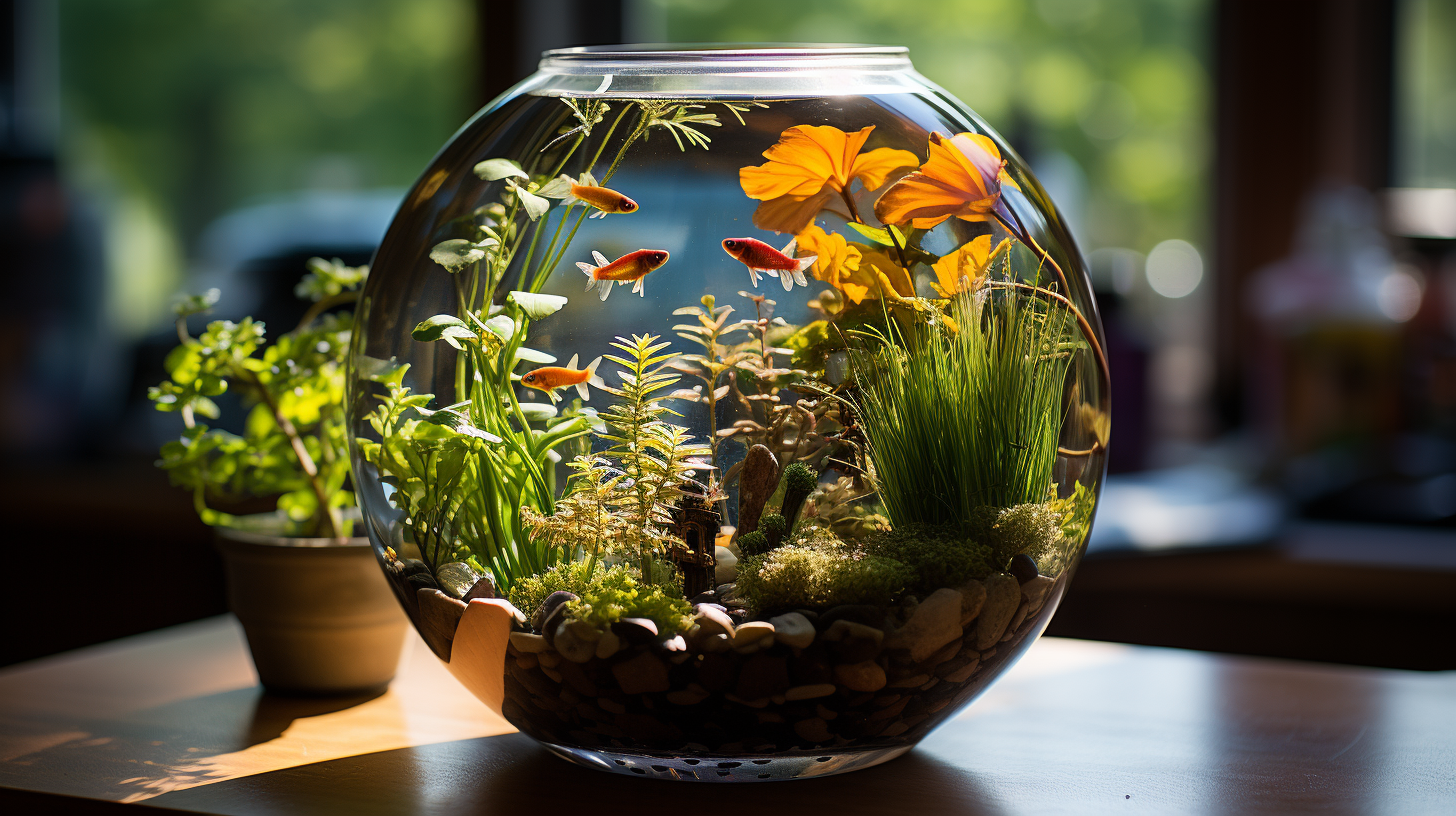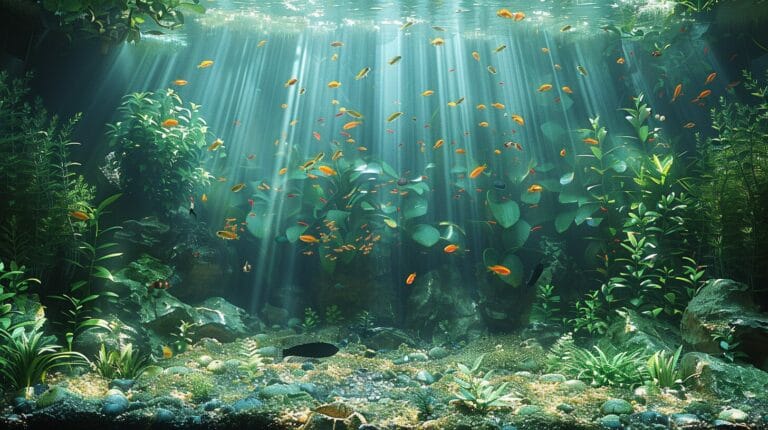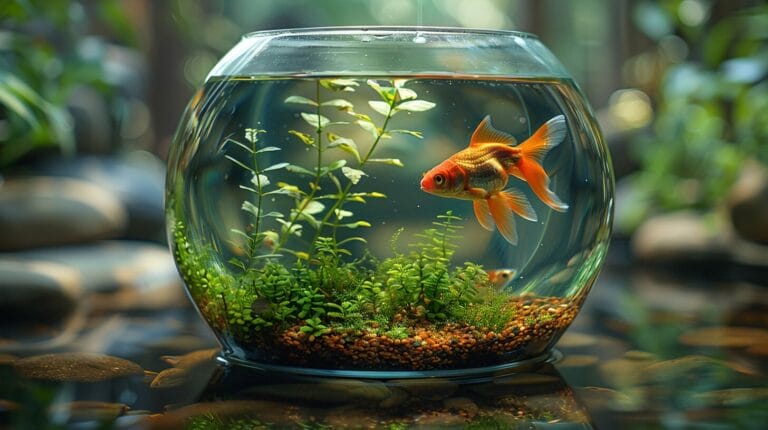In a world where the hustle and bustle of urban living is juxtaposed with the tranquility of nature, isn’t it fascinating to think that you can create a self-sustaining, eco-friendly oasis right in your living room?
Enter the realm of small self sustaining aquariums, a concept that marries the beauty of aquatic life with the principles of ecology. As an eco-conscious individual, you’ll appreciate that these easy-to-maintain fish tanks not only add aesthetic value to your space but can also serve as a testament to your commitment to the environment. For instance, the practice of growing pothos in aquarium can help to filter out toxins and provide oxygen for the fish, creating a harmonious ecosystem within the tank. Additionally, maintaining a self-sustaining aquarium can serve as a constant reminder to live in balance with nature and to take proactive steps towards environmental conservation. With these small aquariums, you can enjoy the tranquility of aquatic life while also contributing to the preservation of our planet.
Key Takeaways
- Small self-sustaining aquariums mimic natural ecosystems
- Choosing the right fish and plants is crucial for a balanced system
- Regular monitoring and maintenance are necessary for a healthy ecosystem
- Implementing eco-friendly practices enhances the sustainability of the aquarium
Understand the Concept of a Small Self-Sustaining Aquarium
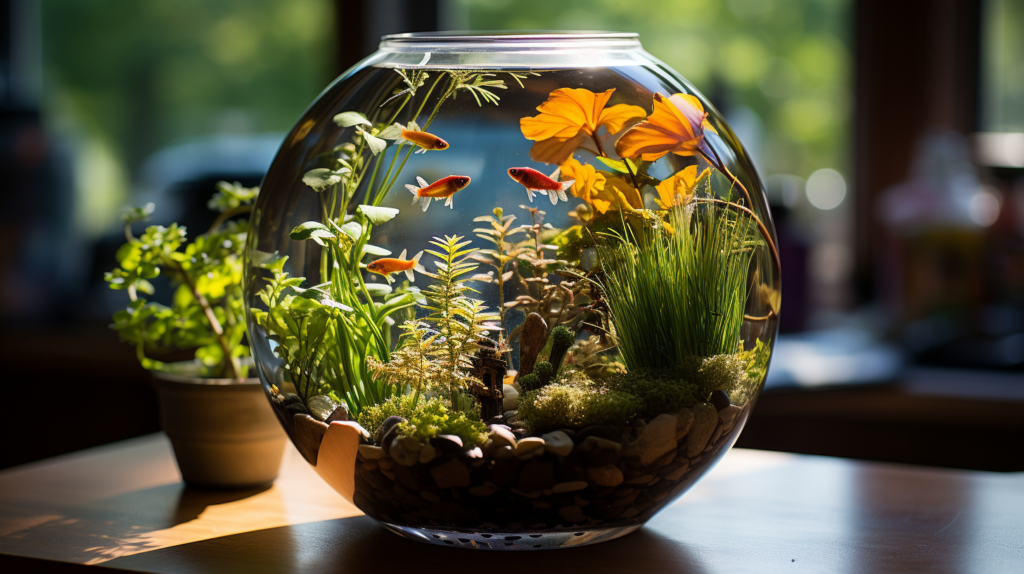
Ever wondered how a small self-sustaining aquarium works and why it’s considered an eco-friendly solution? Well, it’s an intriguing concept and you’re about to understand it. It’s all about creating an autonomous tank that mimics the natural ecosystem, providing an ideal environment for your aquatic friends.
A small self-sustaining aquarium operates on a simple yet fascinating principle: the ecosystem cycle. It involves establishing a balanced system where plants, fish, and bacteria coexist, each playing a vital role. The fish produce waste, which bacteria then convert into nutrients for the plants. In turn, the plants provide oxygen for the fish. It’s a beautiful, perpetually rolling cycle, just like life outside the tank.
So why is it considered an eco-friendly solution? Because it reduces the need for artificial filtration and frequent water changes, saving energy and water. Moreover, it offers a natural home for your fish, free from chemical additives. Now that you understand the concept of a small self-sustaining aquarium, you can take the leap and create your own. It’s more than just a hobby – it’s a step towards sustainability.
Choosing the Best Fish and Plants for a Self-Sustaining Fish Tank
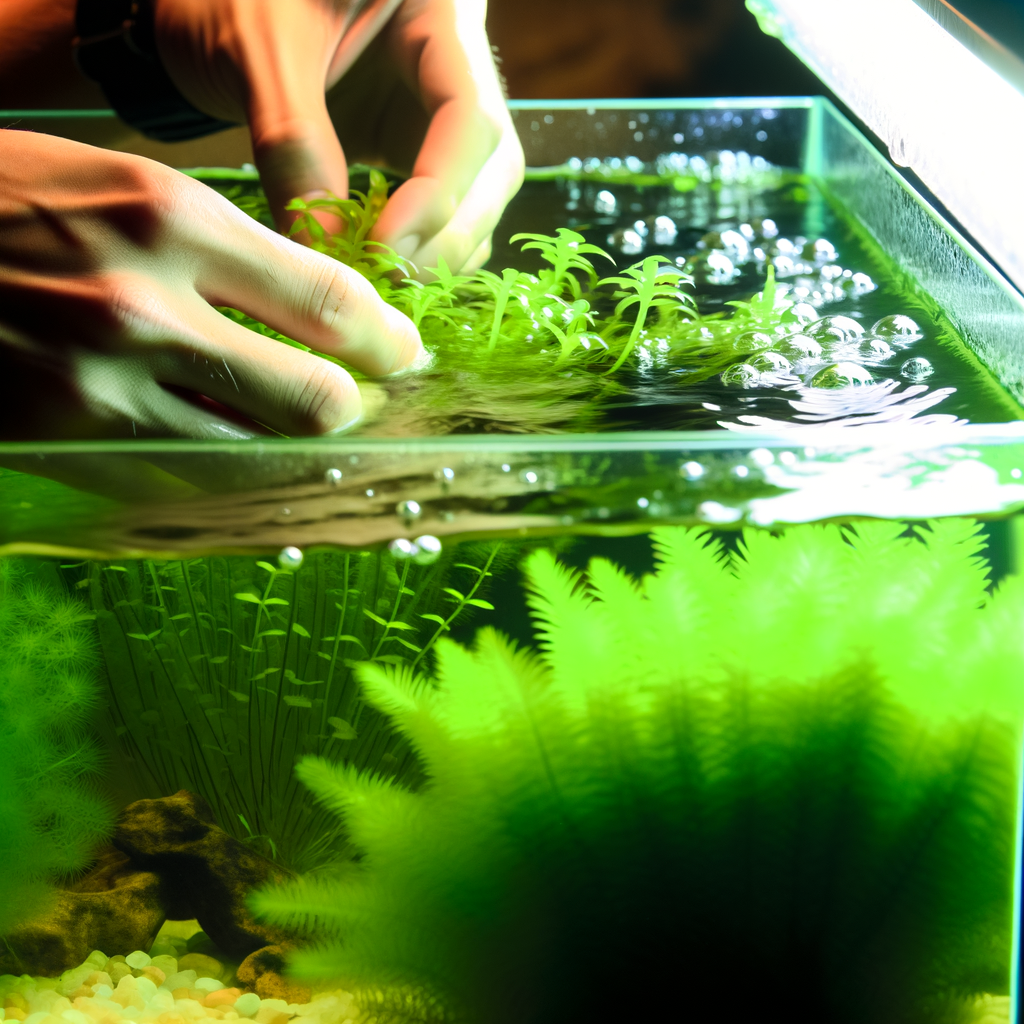
Now that you’ve grasped the concept of a small self-sustaining aquarium, let’s explore how to choose the best fish and plants that will thrive in this kind of environment. Your choices will be critical in establishing a stable, self-sustaining food chain.
Selecting compatible fish species is your first step. Consider small, hardy fish that can adapt to varying water conditions. Good choices include guppies, bettas, and tetras. Remember, the goal is to create a balanced ecosystem, so avoid aggressive species that could disrupt the harmony.
When it comes to aquatic plants, they’re not just for decoration. They play a critical role in maintaining water quality by absorbing excess nutrients and providing oxygen. Some top picks are java moss, anubias, and water lettuce.
Here are a few things to remember when choosing the best fish and plants for a self-sustaining fish tank:
- Choose fish and plants that are compatible with each other and the size of your tank.
- Consider the fish’s dietary needs. Some fish feed on algae and plant matter, contributing to the self-sustaining food chain.
- Pay attention to the light and temperature requirements of your chosen plants.
Guidelines to Create a Self-Sustaining Aquarium

To create your own self-sustaining aquarium, you’ll first need to choose the perfect tank size. This is an essential step in building a self-sustaining aquarium. A smaller tank is easier to manage and fits anywhere in your home, making it an ideal choice for a small self-sustaining aquarium.
Next, you’ll need to arrange your ecosystem. This involves meticulously placing plants and introducing fish. Choose floating plants as they aid in filtration and provide shelter for the fish. As for the fish, choose species that are hardy and can thrive in a closed environment.
Following the guidelines to create a self-sustaining aquarium also involves understanding the necessary elements for a self-cleaning aquarium: sunlight, food, and temperature. Sunlight is necessary for photosynthesis, which keeps your plants healthy. Food, of course, keeps your fish alive. And maintaining the right temperature ensures that both your fish and your plants can thrive.
Ongoing Care for Your Small Self-Cleaning Aquarium

While creating your own ecosystem with an easy eco-friendly fish tank is an exciting process, it’s equally important to understand the ongoing care required for your small self-cleaning aquarium. Your dedication doesn’t end with setting up the tank; it extends to regular tank maintenance to ensure a healthy ecosystem for your aquatic friends.
Firstly, monitor the water parameters regularly. This includes checking the temperature, pH levels, nitrate concentration, and ammonia levels. These factors can significantly affect the health of your fish and the overall ecosystem. Don’t panic if you notice small fluctuations; these are normal. However, significant changes may indicate a problem.
Occasionally, you’ll need to change the water in your small self-cleaning aquarium. But remember, it’s vital to replace only a portion of the water—around 10-15%—to avoid disrupting the natural balance of your tank.
Lastly, always keep an eye out for potential issues, including:
- Algae overgrowth: While some algae are normal, excessive growth can indicate an imbalance in your tank.
- Diseased Fish: Regularly observe your fish for signs of illness, such as unusual behavior or physical changes.
- Overpopulation: Too many fish can strain the ecosystem and lead to problems.
How can I create an eco-friendly, self-sustaining outdoor pond for fish?
Creating a comprehensive outdoor pond fish system starts with selecting a location with natural sunlight. Utilize aquatic plants to help purify the water and provide a habitat for fish. Install a filtration system and regularly test the water’s pH and oxygen levels to maintain a healthy ecosystem for your fish.
Extra Tips to Keep Your Self-Sustaining Aquarium Thriving

Even as you tackle common challenges in your small self-sustaining aquarium: easy eco-friendly fish tanks, you might wonder about adding decorations or making more advanced enhancements to your ecosystem. Here are some extra tips to keep your self-sustaining aquarium thriving. First, consider adding live plants to your self-sustaining aquarium, as they can help to regulate the water quality and provide a natural food source for your fish. Additionally, you may want to research the option of adding small invertebrates, like snails or shrimp, to help with tank maintenance. Finally, be mindful of the size of your aquarium when considering fish additions – large freshwater fish may not be suitable for a small self-sustaining setup.
- Choose the right components and compatible fish: This means selecting species that cohabit well together and won’t outgrow the tank. It’s also crucial to choose plants and decorations that won’t harm your fish or upset the balance of your ecosystem.
- Clean the substrate often: While a self-sustaining aquarium can take care of much of its own cleaning, you’ll still need to keep an eye on the substrate. Over time, waste and uneaten food can build up on the bottom of the tank, which can lead to harmful bacteria growth.
- Using a test kit regularly: This will help you monitor the water quality and ensure that your fish are living in a healthy environment. It can also be an early warning system for any potential problems.
Can the Principles of a Small Self-Sustaining Aquarium be Applied to Creating a Habitat for Arapaima Fish?
Creating a perfect arapaima habitat involves mimicking the self-sustaining ecosystem of a small aquarium. By carefully balancing the fish population, water quality, and plant life, it is possible to replicate a natural environment for arapaima. This ensures their well-being and allows them to thrive in captivity.
Conclusion
Embracing a small self-sustaining aquarium isn’t just about adding a decorative element to your space. It’s about embracing a slice of nature and nurturing an eco-friendly environment right at home.
Remember, it’s not merely about the setup but ongoing care that keeps your aquatic ecosystem thriving. So, enjoy watching your fish glide amidst the floating plants and relish the tranquility it brings.
It’s your own underwater Eden, where beauty truly meets responsibility.
Frequently Asked Questions
What is a small self-sustaining aquarium?
A small self-sustaining aquarium is an ecosystem in itself, where the fish, plants, and microorganisms create a balanced environment that requires minimal maintenance and intervention from the owner.
What are the best plants to keep in a self-sustaining fish tank?
Some of the best plants to keep in a self-sustaining fish tank are java moss, java fern, anacharis, and hornwort. These plants are low-maintenance, help keep the water clean, and create a natural habitat for the fish.
How do I maintain a self-sustaining tank clean?
To maintain a self-sustaining tank clean, you should vacuum the gravel regularly, monitor the nitrate levels, and ensure the plants grow well. Additionally, avoid overfeeding the fish and maintain the right balance of fish to create a natural and healthy ecosystem.
What size tank is suitable for a self-sustaining aquarium?
A small self-sustaining aquarium can range from 5 to 20 gallons, but the ideal size depends on the number and size of fish you want to keep and the number of plants in the aquarium. It is important to maintain the right balance for a healthy ecosystem.
How do I set up a self-sustaining aquarium?
To set up a self-sustaining aquarium, you will need to create a natural environment with appropriate live plants, a self-cleaning fish tank, a suitable rooting medium for the aquarium plants, and the right number and size of fish. Additionally, you should ensure that the tank is ready for fish before introducing them.

